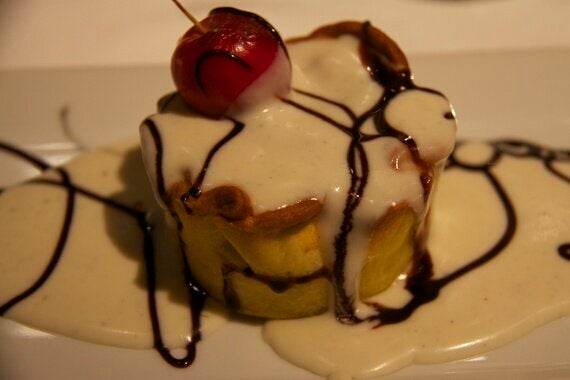It seems there is money to be made in counterfeiting any product - even cheese is fair game - I wonder if you've ever tried gorgonzola that's actually not the real deal and how would you know? The creamy blue-veined pasteurised cow's milk cheese is one of the most famous and copied Italian blue cheeses in the world. Formaggio fraudsters often make copycat cheese, selling it under names ending in "zola" which fool customers into thinking they're buying the genuine article, only to be disappointed when they unwrap it at home. I went on a fact-finding mission to North-West Italy to discover how and where true gorgonzola is made.
It's in Novara where you'll find the Gorgonzola Consortium - a non-profit making organisation established to protect the brand and the producers who make it. Only real gorgonzola is marked with
on the aluminium foil that protects it and can only be applied by producers authorised by a Consortium.
In order to obtain its PDO certification the cheese has to be prepared, processed and produced within a specific region and have characteristics special to that area.
Gorgonzola can only be produced in Novara, Vercelli, Cuneo, Biella, Verbano Cusio Ossola, and the area of Casale Monferrato within the Piedmont region, and Bergamo, Brescia, Como, Cremona, Lecco, Lodi, Milano, Monza, Pavia, and Varese within the Lombardy region.
The Invernizzi family has been producing high quality gorgonzola for three generations and it's here in their state-of-the-art factory that they produce 400 wheels of cheese each day.
Photo by Rebecca Williams
The milk is delivered from the cows of Consortium members. Before its processed, its pasteurised and then warmed to about 30°. Milk enzymes are added to the milk, along with the rennet and the spores of selected cultures that give gorgonzola its distinctive blue veins and creamy texture and flavour.
Photo by Rebecca Williams
The master cheese-maker decides when the curd, produced by the milk coagulation, is ready to be worked by the massive stainless steel mandolin. It's the scary looking mesh paddle to the left of the vat.
Photo by Rebecca Williams
The curd is broken up and tipped onto a specially perforated table where the whey drains.
Photo by Rebecca Williams
Photo by Rebecca Williams
Photo by Rebecca Williams
From there, the curd is transferred to moulds which are punctured around the sides, each mould holds 15kg of fresh cheese. The holes allow extra whey to run off.
Photo by Rebecca Williams
The curd stays in the moulds (known as fascere or fassiroli) until the next morning, up until then they're turned to help the whey to drain off. It's then that the cheese-maker adds their specific stamp which identifies where the cheese has been made. This stamp links the cheese to the Si Invernizzi factory.
Photo by Rebecca Williams
Photo by Rebecca Williams
The next day the cheeses are put through the salting machine, first around the whole wheel, then the top and bottom.
Photo by Rebecca Williams
Repeated again the next day, the cheese is kept in an area where the temperature is controlled to approximately 20°C and between 90 and 95 percent humidity. It's known as the 'stewing phase' where the cheese continues to drain whey.
Photo by Rebecca Williams
It's another 24 hours in the stewing chamber for the cheese and then it's transferred to a cold room where the temperature drops to 4°C. It begins the maturing phase and it's very important that the temperature is constantly monitored.
Photo by Rebecca Williams
Seven days later and the cheese moves to the perforating and salting process. Each cheese wheel is pierced 100 times to a depth almost equal to its height.
Photo by Rebecca Williams
Next the cheeses are washed with a salt and water solution, a process which is repeated several times. After a week, the same operation is repeated on the opposite surface. The perforations allow air to react with the mould injected at the start of the milk process.
Maturing continues post-salting and the cheese is wheeled to various cold rooms, at temperatures between 3°C and 5°C and a humidity of 90-100%. Depending on the type of gorgonzola, the wheels can spend something between 60 and 90 days in this environment.
The dolce or mild gorgonzola has a delicate taste, it's more creamy and less developed veins of mould run through it. It's left to mature for about two months. Authentic dolce is wrapped in dark blue foil with the trademark
Photo by Rebecca Williams
Piccante or mature gorgonzola has a firmer texture and a much stronger taste. There are lots of veins of mould and this is matured for three months. The piccante is wrapped in green foil.
Photo by Rebecca Williams
The locals are proud of their Gorgonzola, the cheese-seller in Casa del Parmagiano didn't actually wanted me to buy any, he just wanted to feed me.
Photo by Rebecca Williams
So, to recap, any 'gorgonzola' that is made outside of Piedmont and Lombardy isn't true gorgonzola. If your cheese packet which is marked 'gorgonzola' does not have the red and gold PDO stamp.
OR the obvious g
then it's just not what it says it is. Nothing tastes like oozing gorgonzola on crusty bread served with a savoury jam

Photo by Rebecca Williams
or a sweet cherry and cheese dessert.

Photo by Rebecca Williams